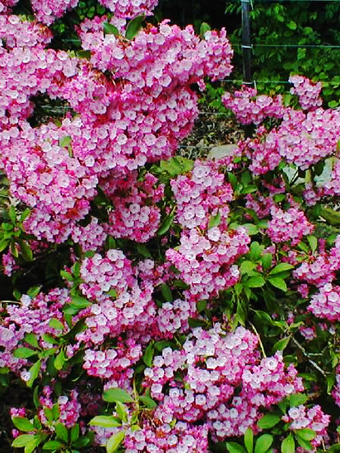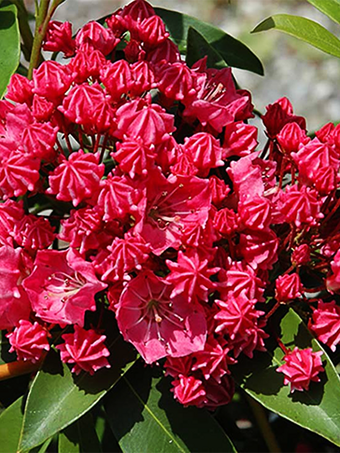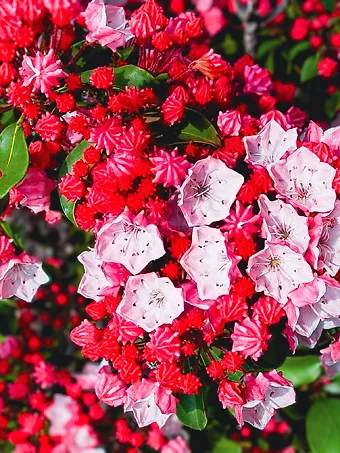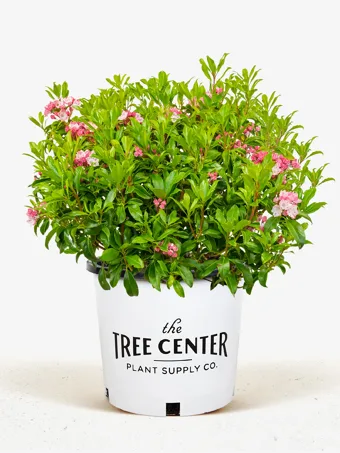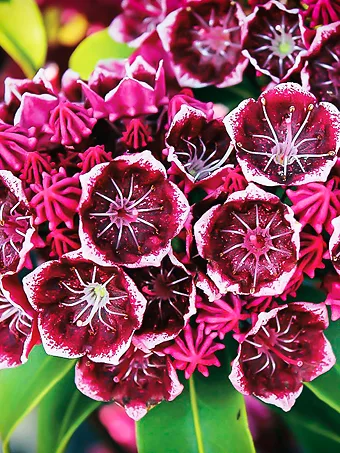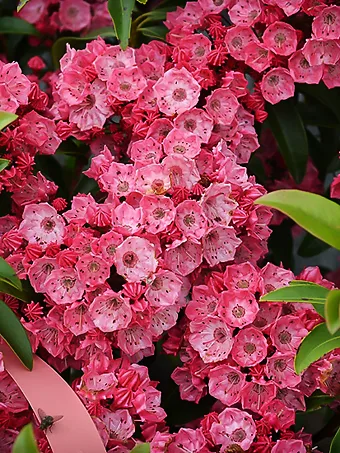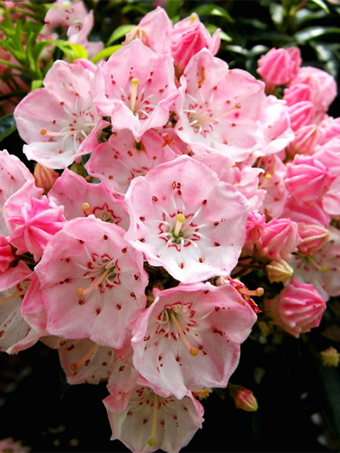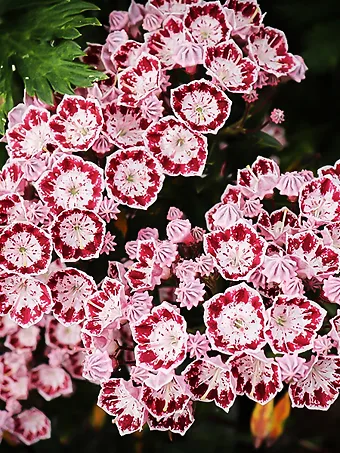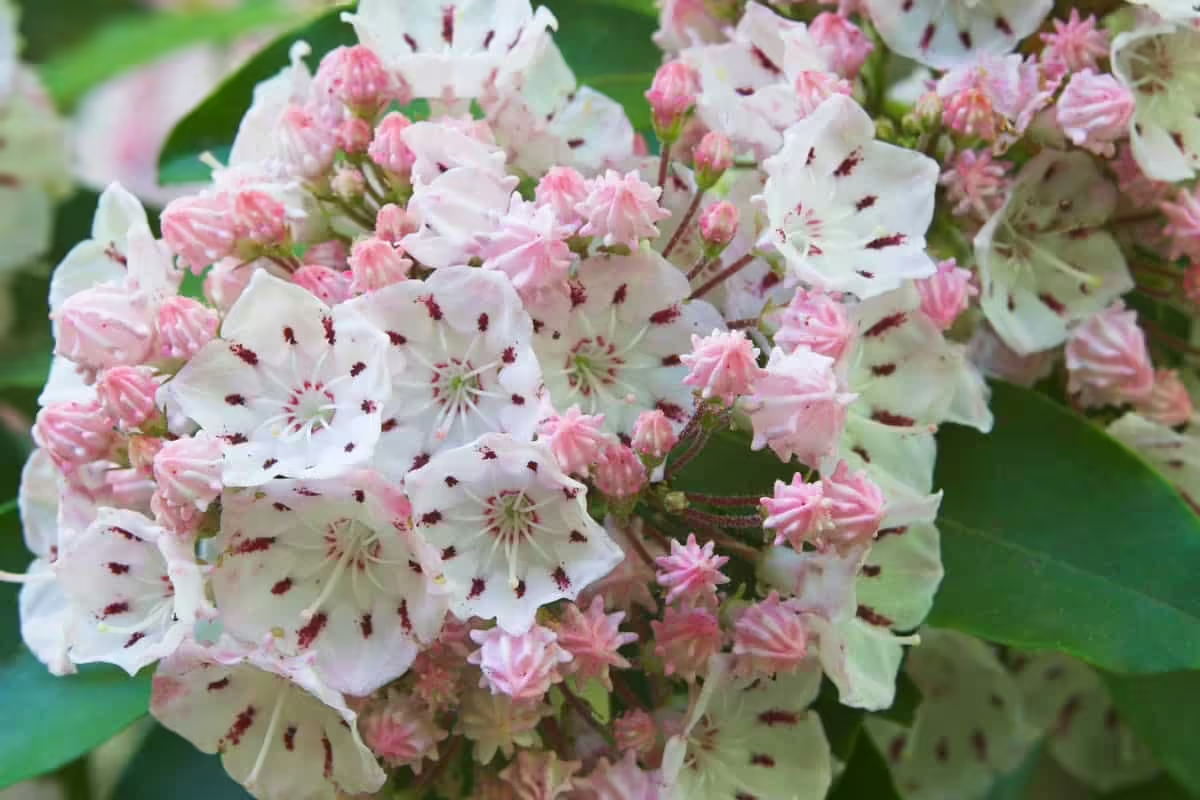
Written by s • The Taming of the Mountain Laurel
Across the hills of a large part of eastern North America, carpeting the forest floor beneath trees, growing on slopes, or edging streams, grows the mountain laurel. Found all the way from southern Maine to northern Florida, and abundant in New England, it spreads west into Indiana and down to Louisiana. Called by botanists Kalmia angustifolia, settlers called it calico-bush, or spoonwood, because its hard, dense wood was perfect for carving spoons, something Native Americans probably did first. They also used it on the skin as a painkiller. It was known to farmers as ‘lamb-kill’, because its poisonous leaves killed sheep, although deer eat it more cautiously, and don’t die. So densely did it grow in the Appalachian forests that it made passing through very difficult, and it was called ‘laurel hell’. It has a northern relative in Canada, the sheep laurel, Kalmia angustifolia, whose name also refers to its toxic qualities for sheep, as well as calves and pigs. Despite this, the Mountain Laurel was declared the state flower of both Connecticut and Pennsylvania in the early decades of the 20th century.
Kalmia, Mountain Laurel
The flowers on wild trees are pale pink, opening to almost white, but they are in dense clusters and certainly quietly attractive. This plant doesn’t wait for insects to casually be dusted with pollen. Instead, the stamens are tucked into a fold of the petals, and when an insect lands on the flower they are released, shooting the pollen forcefully onto the insect. In some areas it may become tree-like, up to 30 feet tall, but more often it is a 5 to 15-foot-tall shrub or twisted branches, with peeling reddish-brown bark.
Perhaps because it is widespread, and has toxic qualities, it seems that no-one thought particularly of growing it in gardens – a certain contempt for wild plants was once common among gardeners, who often preferred to grow plants brought from Europe, or even better from somewhere exotic, like China or Japan. So for decades the mountain laurel remained a wild creature, loved by naturalists and children playing in the woods, but largely ignored for gardens. Its need for acid soils shouldn’t have been a major barrier, since acid soil is typical of much of the eastern states, as the gardens filled with azaleas and camellias (both exotics from the East) makes clear.
To tame this rangy wild plant would take some dedication, and to become popular it needed to be brought down in size, and more color brought into those flowers. It did have a lot of potential though, because the flower buds are prominent for weeks before blooming happens, and the flowers last well too. Plants for acid soils are generally popular, and it was just a matter of time before the garden potential of the wild mountain laurel was recognized by someone.
And then along came Jaynes. . .
Although others had a go, in America one man stands out as the father of the many garden varieties of this plant we have today. He was not someone trying to get rich, but a dedicated scientist and plant breeder, Richard A. Jaynes. In 1961 Jaynes began working at the Connecticut Agricultural Experiment Station in New Haven, part of the state’s Department of Agriculture. As a student he worked on breeding disease-resistant chestnuts trees, and some of his varieties are still grow today. Then he turned his attention to developing improved forms of the mountain laurel, work he continued after he retired, at his own Broken Arrow Nursery in Hamden, Connecticut.
When Richard Jaynes first began, he know that he needed a variety of forms to work with, so he explored and collected any mountain laurel he could find that was a little different. Gardeners are used to named plants being identical, as they should be, but we don’t always realize the enormous variety that exists in wild populations of plants. They vary a lot in size, flower color, and other features. Jaynes gathered all the unusual colors and shapes he could find, and once his work became known other horticulturists contributed plants they had. One natural variation, the variety called myrtifolia, was especially promising, because it has much smaller leaves and a more compact size than most other wild mountain laurels, making a more ‘garden friendly’ plant. Another, called fuscata, has a narrow band of color inside the cup-shaped flower, a trait that would become a big source of color and variety for garden plants.
As early as 1971 Jaynes had some new varieties which emphasized the pink coloring of the developing buds. Looking like icing flourishes on a cake, the conical, five-sided buds were bright red in his plants, called ‘Nipmuck’ and ‘Quinnipiac’, extending the time the plants show color, and today something common in most garden varieties. One of Jaynes most popular and widely-grown plants is ‘Minuet’, which has red buds, a broad dark red band inside the flower from fuscata, and the dwarf form of myrtifolia – a true example of the art of plant breeding. This plant was bred in 1978, but unlike many commercial breeders, who can’t wait to get their plants out making money, Jaynes took a decade to release it, after extensive testing for its garden worthiness and durability.
With some help from his friends. . .
Richard Jaynes may be the person most associated with breeding new mountain laurels, but he was not alone. Although not native there, the climate in the north-west is ideal for growing them, and John Eichelser, who lives in Olympia, Washington, has been a prominent breeder. Starting around the same time as Jaynes, he worked with one of the very few old selections, a plant called ‘Ostbo Red’, from 1940. The product of an earlier generation, that plant had been created by Endre Ostbo, a professional gardener in Medina, Washington, whose main interest was dwarf rhododendrons. John Eichelser grew some seed he collected from his ‘Ostbo Red’, and among the seedlings was a gorgeous plant with deep red buds and bright pink flowers. He called it ‘Olympic Fire’ and released it in 1978.
From one to many. . .
There was another reason why mountain laurel had resisted domestication, and why there were few garden varieties. When a new plant is created, it must be reproduced clonally, so that it is genetically identical to that special parent. Mountain laurel is hard to reproduce. Taking stem pieces and rooting them is the route nurseries prefer, but this can be tricky with mountain laurel – some root reasonably well, but others simply won’t do it. Even if you succeed, it takes years to produce a plant of a decent size, with a strong root system. Nursery growers don’t like this – to make a profit they need plants that can be grown easily, and then quickly marketed.
The science of tissue culture provided the answer to the problem of how to get the increasing flood of new varieties coming from Jaynes, Eichelser and other breeders. Starting with just a few shoots, it is today possible to create hundreds of plants simultaneously in test-tubes, growing the tiny plants under lights in climate-controlled environments. Within a few years, sturdy, identical bushes that are true to type are ready for waiting gardeners to plant them in a damp, lightly-shaded area, and wait for the beauty of these plants to shine in their gardens.
If you haven’t joined the Mountain Laurel Fan Club yet, you should. These beautiful shrubs have a special charm, and the many special varieties available bring something truly unique to your garden.
